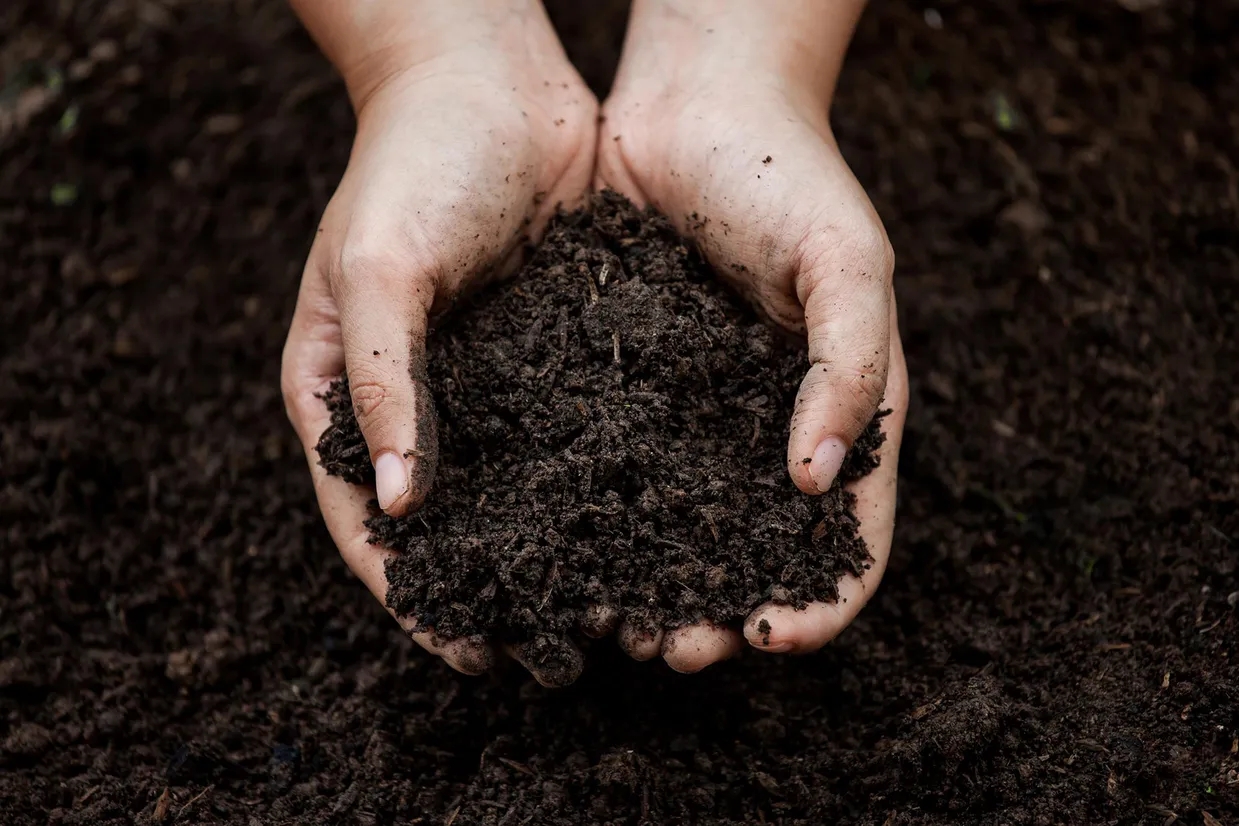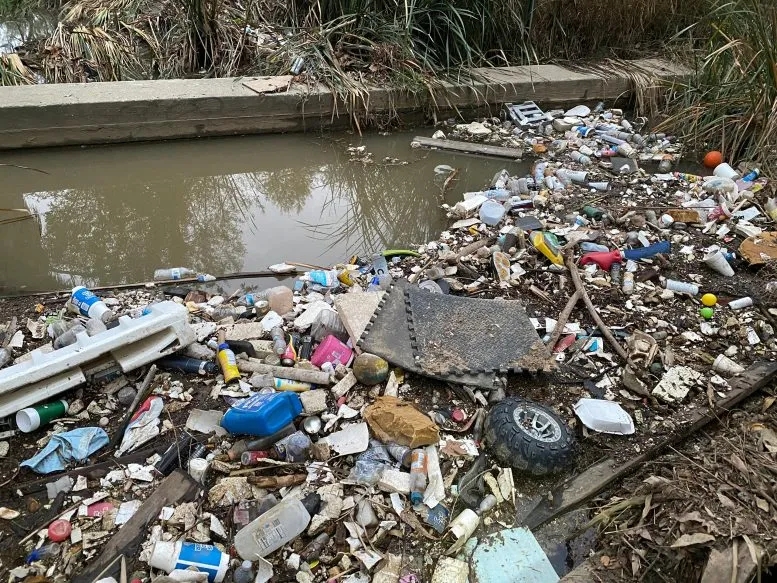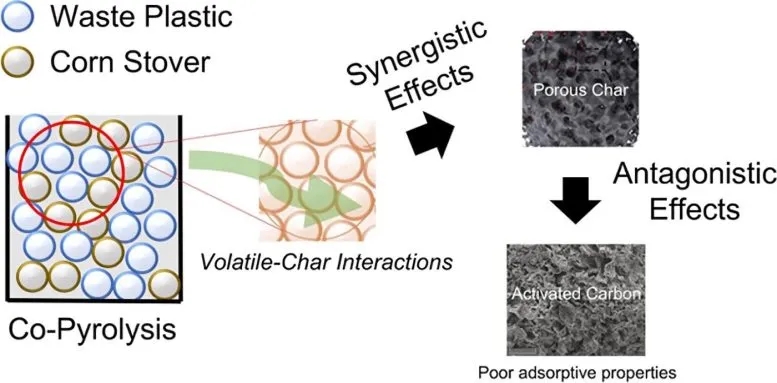博文
科学家将塑料垃圾转化为有价值的土壤添加剂
||
科学家将塑料垃圾转化为有价值的土壤添加剂
诸平



Fig. 3 The char and activated carbon making process. Credit: UCR
据美国加州大学河滨分校(University of California – Riverside简称UCR)2023年1月13日报道,科学家将塑料垃圾转化为有价值的土壤添加剂(Scientists Transform Plastic Waste Into a Valuable Soil Additive)。
塑料改变了我们的生活,但是塑料污染对环境造成的影响也是一个世界性的难题。UCR的最近的一项研究详细介绍了一种将塑料废物转化为高度多孔形式的木炭的方法,这种木炭的表面积很大(约400 m2/g)。这种木炭有可能捕获碳并改善农田的土壤保水性和通气性,同时还可以在自然分解时为土壤施肥。这种方法可能是解决塑料垃圾问题和促进农业发展的有效途径。UCR的方法从塑料和玉米秸秆等废料中制造出有用的炭。相关研究结果于2022年12月21日已经在ACS Omega杂志网站发表——Mark Gale, Peter M. Nguyen, Kandis Leslie Gilliard-AbdulAziz. Synergistic and Antagonistic Effects of the Co-Pyrolysis of Plastics and Corn Stover to Produce Char and Activated Carbon.ACS Omega, 2023, 8(1): 380–390. DOI: 10.1021/acsomega.2c04815. Publication Date: December 21, 2022. https://pubs.acs.org/doi/10.1021/acsomega.2c04815
UCR的科学家们离找到每年产生的数亿吨塑料垃圾的用途又近了一步,这些塑料垃圾经常堵塞溪流和河流,污染我们的海洋。对于土壤和地下水造成的污染问题同样不可轻视。美国加利福尼亚州河滨市费尔蒙特公园(Fairmount Park in Riverside, California)河床上的塑料垃圾(Fig. 2)就是例证之一。
在最近的一项研究中,UCR 化学与环境工程助理教授坎迪斯·莱斯莉·阿卜杜勒-阿齐兹(Kandis Leslie Abdul-Aziz)和她的同事详细介绍了一种将塑料废物转化为高度多孔形式的木炭的方法,其表面积高达约约400 m2/g。
这种木炭捕获碳,并有可能被添加到土壤中,以改善土壤保水性和农田通气性。它还可以在自然分解时为土壤施肥。然而,坎迪斯·莱斯莉·阿卜杜勒-阿齐兹警告说,需要做更多的工作来证实这种炭在农业中的效用。
将塑料转换为木炭的过程,是在加州大学河滨分校的马兰和罗斯玛丽·伯恩斯工程学院(UC Riverside’s Marlan and Rosemary Bourns College of Engineering)开发的。它涉及将两种常见类型的塑料中的一种与玉米废料——剩余的茎、叶、壳和玉米芯——统称为玉米秸秆混合物。然后将此混合物用高度压缩的热水煮熟,这一过程称为水热碳化(hydrothermal carbonization)。
这种高度多孔的木炭是使用用于聚苯乙烯泡沫塑料包装的塑料即聚苯乙烯(polystyrene)和通常用于制造水瓶和汽水瓶等许多其他产品的材料即聚对苯二甲酸乙二醇酯(polyethylene terephthalate简称PET))生产的。
该研究是在早期成功尝试(earlier successful effort)单独使用玉米秸秆制成活性炭后进行的,该活性炭用于过滤饮用水中的污染物。在早期的研究中,仅用氢氧化钾活化的玉米秸秆制成的木炭能够从测试水样中吸收98%的污染物香兰素(vanillin)。
在后续研究中,坎迪斯·莱斯莉·阿卜杜勒-阿齐兹和她的同事想知道由玉米秸秆和塑料制成的活性炭是否也可以成为一种有效的水处理介质。如果是这样,塑料废物可以重新用于清理水污染。但她说,由混合物制成的活性炭仅吸收了测试水样中约45%的香兰素——这使其无法有效净化水。木炭和活性炭的制作过程见图3(Fig. 3)所示。
“我们推测,此(活性炭)材料表面可能仍有一些残留塑料,这阻止了表面吸收其中一些(香兰素)分子,”她说。
尽管如此,通过结合塑料和植物生物质废料来制造高度多孔木炭的能力仍然是一项重要发现,正如上述论文(paper)中所详述的那样。
坎迪斯·莱斯莉·阿卜杜勒-阿齐兹说:“它可能是一种非常有用的生物炭,因为它是一种非常高的表面积材料。所以,如果我们只是停留在炭化而不是将其转化为活性炭,我认为我们可以利用很多有用的方法来利用它。”
塑料本质上是一种固体形式的石油,会在环境中积累,污染、缠绕、窒息和杀死无意中摄入塑料的鱼类、鸟类和其他动物。塑料还会分解成微粒如微塑料(microplastics),这些微粒可以进入我们的身体并破坏细胞或诱发炎症和免疫反应。
不幸的是,回收用过的塑料比用石油制造新塑料的成本更高。因此对于塑料的回收企业不感兴趣。
坎迪斯·莱斯莉·阿卜杜勒-阿齐兹的实验室采用了不同的回收方法。它致力于通过将塑料和植物生物质废料等有害废物升级为有价值的商品,将其重新投入经济循环之中。
她说:“我觉得我们对塑料回收有更多不可知论的方法,当你可以将它与生物质一起扔进反应炉,并使用产物炭来改善土壤时,这就是我们的想法。”
本研究得到了加州大学河滨分校(UCR)和加州大学卓越领导力高级学位{ University of California’s Leadership Excellence through the Advanced Degree (UC LEADS) program }项目的财政支持。
上述介绍,仅供参考。欲了解更多信息,敬请注意浏览原文或者相关报道。
The physicochemical properties of char and activated carbon produced from the co-pyrolysis of corn stover (CS) and plastics, polystyrene (PS) and polyethylene terephthalate (PET), were studied. Non-isothermal gas analysis of the volatiles was conducted using an online mass spectrometer to correlate the thermal degradation of gaseous byproducts to the formation of pores in the char materials. The findings determined that the addition of PS or PET promotes the formation of the solid char product with either higher than average pore sizes or surface areas compared to control samples. The addition of PET to corn stover increases the surface area of the char formed. The char formed from a CS:PET mass ratio of 1:1 produced char with a surface area of 423.8 ± 24.8 m2/g at 500 ℃ and a duration of 2 h. The surface area of the chars formed from CS and PET decreased as the amount of PET decreased, showing a tendency for PET to increase the surface area of the char materials synergistically. The addition of PS to corn stover promoted the formation of chars with, on average, larger pore sizes than the control char samples. The chars were chemically activated with potassium hydroxide, and the activated carbon that formed had lower surface areas but comparable surface functional groups to the control samples. Vanillin adsorption testing showed that activated carbon from corn stover performed the best at removing 95% of the vanillin after 2 h. In contrast, the activated carbon from the chars produced from the co-pyrolysis of corn stover and polystyrene or corn stover and polyethylene terephthalate removed 45% and 46% of vanillin after 2 h, respectively. The findings suggest that plastics have a synergistic relationship in producing char precursors with improved porosity but antagonistically affect the activated carbon adsorbent properties.
https://blog.sciencenet.cn/blog-212210-1372199.html
上一篇:迈向绿色未来的巨大飞跃:可持续氨和化肥生产的突破
下一篇:非凡的发现可能会极大地改变我们对光合作用机制的理解